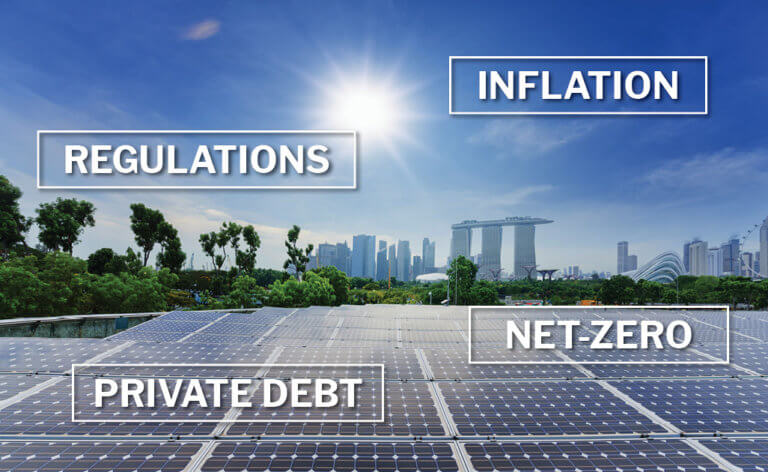Insurers lobby for removal of green infrastructure investing roadblock
February 22 2024 by Georgina Lee- Asia Pacific
- China
- Hong Kong
- Singapore
- Infrastructure
- Renewables
- Asset Management
- Capital Markets
- Climate
- ESG
- P&C
- abrdn
- Schroders
- Zurich

Insurers globally are lobbying for regulatory changes that would enable them to invest more capital into green infrastructure assets. This week, the Association of British Insurers has urged the authorities to scale up private & public partnerships to stabilise the return of green infrastructure projects, arguing that this would help turn them into investment-grade assets and become eligible for their investments.
In Hong Kong, the industry has also been lobbying the regulator to recognise such collaboration for lower capital charges, but this has yet to be reflected in the upcoming iteration of the risk-based capital (RBC) regime. The same goes for the RBC regime In Singapore, although the Monetary Authority of Singapore said in November 2023 that they would soon launch a consultation on proposed capital treatment.
Green infrastructure investing has long been touted as a good match for insurers’ long-term liabilities such as life insurers’ annuity books and life covers. But it is just as relevant for non-life insurers due to the nature of general insurance claims tends to make P&C insurers more exposed to inflation risk than life insurers. Inflation erodes the value of a currency and the immediate impact for (re)insurers would be a rise in the claim amounts.
“Infrastructure equity, particularly renewable energy, is a natural stable growth asset which offers attractive yields and inflation-linked income,” said Matthew Pang, head of institutional business, Hong Kong at Schroders, adding that he expects a return of 10-12% in US dollar terms from such assets.
(Re)insurers are also feeling a growing urgency to support infrastructure projects, as governments’ attempt to fulfil their net-zero goals has significantly raised the finance needed to transition carbon-intensive sectors into new low-carbon infrastructure. About US$50 trillion in incremental investments are required by 2050 to transition the global economy to net-zero emissions to avert a climate catastrophe, according to a report co-authored by the World Economic Forum and Oliver Wyman.
Initiatives such as the Principles for Sustainable Insurance (PSI); and disclosure frameworks such as the Task Force on Climate-related Financial Disclosure are propelling (re)insurers to invest more in sustainable, long-term assets, as they underwrite more renewable energy infrastructure and decarbonisation technologies that tick the boxes on environmental, social and governance (ESG).

Infrastructure equity, particularly renewable energy, is a natural stable growth asset which offers attractive yields and inflation-linked income. Floating-rate infrastructure debt gives insurers an access point to attractive returns without taking on undesired interest rate risk and related solvency capital requirement.
Matthew Pang, Schroders
These green assets include combined cycle power projects, hydroelectric power projects and renewable energy projects, including wind, solar, and battery energy storage systems.
“Over the past decade, the majority of P&C insurers have been transitioning away from insuring fossil fuel projects, particularly those involving coal. As a result, their risk profiles have gradually shifted towards other non-fossil fuel projects,” said Jim Qin, chief executive of general insurance at Zurich Insurance (Hong Kong).
Higher yield, lower vol
Interest among (re)insurers on infrastructure investing appears to be on the rise. If investment into private debt is used as a proxy for their interests in infrastructure, insurers’ investment into private debt through third-party managers has grown to US$270 billion in 2021 from US$20 billion in 2015, according to data from Clearwater Analytics.
Insurers prefer investing in private assets, such as through private debt or private equity, as their spreads generally benefit from a premium associated with their lower liquidity compared to publicly traded securities, according to Xiong Jian, senior Insurance solutions director for UK-headquartered global asset manager abrdn.
“Additionally, issuers are more willing to tailor the investment cashflow of the private instrument to match the insurers’ liability profile. The insurer may also be able to negotiate for terms that give them better investors’ protection compared to a conventional public bond,” Xiong Jian, senior Insurance solutions director for abrdn based in Singapore.
Floating-rate infrastructure debt gives insurers an access point to attractive returns without taking on undesired interest rate risk and its related solvency capital requirement, said Pang at Schroders.
“Floating-rate loans can be issued across the credit risk spectrum, giving investors a range of options from investment grade to high yield and even hybrid investments with debt and quasi-equity elements. Currently, we see spreads of 200-600 basis points (bps) above risk-free rates in USD terms depending on the type of instrument, seniority, and level of risk,” said Pang.
Infrastructure assets also provide stability and resilience to insurers’ portfolios. Long-term studies by Moody’s found that the 10-year average loss rate of BBB-rated infrastructure debt over the last four decades was more comparable to A-rated corporate debt, said Ruolin Wang, insurance solutions manager at Schroders Investment Management.

Insurers prefer investing in private assets, such as through private debt or private equity, as their spreads generally benefit from a premium associated with their lower liquidity compared to publicly traded securities. Additionally, issuers are more willing to tailor the investment cashflow of the private instrument to match the insurers’ liability profile.
Xiong Jian, abrdn
Bridging the gap
But among all different types of investors, insurers’ asset allocation to the sector appears insignificant to their total assets, amounting to just 1.5% of their assets under management in 2019, a World Bank report released in 2021 shows. A 5% allocation of insurers’ gross written premiums into infrastructure investments could close nearly half of the annual investment gap, the World Bank said.
In April 2023, the Hong Kong Federation of Insurance (HKFI) has asked the government to allow the use of internal ratings for infrastructure and recognise the diversification benefits from infrastructure debt and equity under the risk-based capital (RBC) regime.
While the Hong Kong government has accepted one of their proposals in giving a discount to the capital risk charge for green bonds, capital charges for long-term infrastructure or real assets have not been spelt out, an HKFI spokesperson said in an email response to InsuranceAsia News.
This puts Hong Kong behind China, where under the China Risk-Orientated Solvency System (C-ROSS II) regime, concessions are given in the primary risk factor used to calculate capital risk charge for infrastructure equity is 12%, compared to 31% for listed equity in general. For private infrastructure debt, there is also a 50 bps reduction compared to a double-A-rated publicly issued corporate bond, according to Xiong.
Instead, governments are dishing out other incentives to encourage more (re)insurers’ capital into green infrastructure.
In Singapore, Bayfront Infrastructure, backed by Clifford Capital and Asian Infrastructure Investment Bank, has already structured four infrastructure asset-backed securities that offer investors a portfolio of infrastructure loans and bonds extended by five participating banks to project owners in and outside the region. The Government of Singapore has provided guarantees to these deals.
“For now there has not been any favourable capital risk charge given in the risk-based capital regime of Hong Kong and Singapore. But as the RBC regime continues to evolve this may be reconsidered in the future,” said Xiong.
-
QBE | Elevating customer experience, humanising claims: QBE Asia’s ‘Solutions in a Box’
Vastly improving turnaround times and personalising service delivery, QBE Asia’s award-winning, end-to-end bundled claims solutions is a game-changer for the insurance industry.
-
Beazley | What does cyber protection look like from day 1 to day 600 and beyond?
Cybersecurity is no longer just an IT concern, but a governance issue that belongs on the boardroom agenda.
-
Sedgwick | Preparing for the next storm
Insurance industry needs to recalibrate, invest in innovation and strengthen systems, talent and data practices.
-
Peak Re | From climate modelling to market opportunity: Forging a new clarity on Southeast Asia’s climate risk
Southeast Asia's protection gap: a crisis of clarity, not just capital

